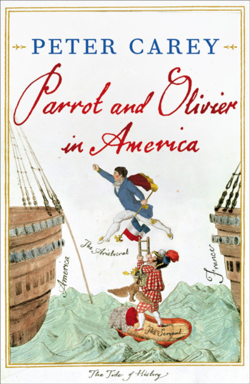
Years ago -- in 2007 to be exact -- I read and reviewed Peter Carey's Booker-winning Oscar and Lucinda. I absolutely loved it, and have been meaning ever since to read another of Carey's many novels. I did try his other Booker-winning True History of the Kelly Gang, but couldn't get past the dialect (or "dazzling act of ventriloquism" as the blurb calls it). Anyway, I finally made it, listening to this as an audiobook, which took a very very long time. This was partly due to the fact that it is a very long book, but also partly because it took me a while to get engaged with it.
Parrot and Olivier in America is a book in two halves, or rather it is narrated alternately by the two protagonists. They are Olivier-Jean-Baptiste de Clarel de Barfleur de Garmont, a French aristocrat born in 1805, and John Larrit, nicknamed Parrot, a sometime engraver and son of a printer, who is 24 years older. These two could not be more different in every possible way, from their social status to their life experiences, and yet, by a series of complicated coincidences, they end up traveling together to America, with Parrot acting as secretary to Olivier, though actually paid to spy on him by his mother's lover.
It's hardly surprising that initially, and for quite a long time, the two men dislike each other intensely. Olivier, a sickly, cossetted child, has grown into an effete, snobbish young man whose knowledge of the real world is more or less zero. Parrot, on the other hand, could scarcely have had a fuller life. It was the descriptions of his early childhood that really drew me into the novel -- roaming the English countryside with his loving, free-thinking father, living and working at a firm of printers who turned out to be secret forgers, being saved from almost certain death by the one-armed counter-revolutionary Marquis de Tilbot, ending up on a convict ship headed for Australia, and much more besides. But both men are changed by their experiences in the new world, and by the end they have come to respect, perhaps even love, each other.
But that's really to over-simplify. Of the two it is Olivier who has the most learning to do, and he does it partly by means of the job he has been sent over to carry out -- to write an account of the prison system in America. This brings him into contact with many of the top men in the country -- brash, uncouth, very different from anyone Olivier has ever met before, but men who he comes in some ways to appreciate for what they are. Chief among these is Mr Godefroy, who takes Olivier under his wing and shows him round the country, and with whose daughter, the beautiful, liberated Amelia, Olivier falls desperately in love. But Parrot, too, after many a challenging adventure, really comes to his own in the end, forging a life and a career for himself that would have been impossible anywhere else in the world.
The novel is full of historical references, the most obvious of which is that Olivier is based quite closely on Alexis de Tocqueville, a French nobleman who did travel to America and did write a book about it. But there's also an allusion to the great engraver Audubon, whose famous book of American Birds is here engraved and published by Parrot's friend and employer, the ex-forger Mr Watkins, and probably lots more that I missed. I didn't find out about de Tocqueville till very late in the day, and frankly when I did it didn't matter to me in the least. Similarly, I've seen the accounts of Parrot's history being described as Dickensian. Well, who cares if they are. The book is a wonderful mish-mash of many disparate elements, and where they originated is not important. What has emerged is the product of Carey's wonderfully vivid and wide-ranging imagination, and it is not only enormous in its size but also enormous in its ability to give all kinds of pleasure, or I found it so, anyway. It's often very funny, especially when, as often, we see the same events described by both protagonists, who see things in very different ways. It's touching to see these two men gradually coming to a better understanding of each other, and very entertaining to get a glimpse of early 19th-century New York, where pigs run wild and cause havoc on Broadway, Times Square is essentially a sea of mud, and Harlem, where Parrot and his beautiful painter wife end up living, a small country village. The writing is wonderfully colourful and full of great descriptions -- a bunch of old ladies sitting in a dark parlour, "wetting their hairy chins with stout", sailors clinging to the rigging of a ship "like soft fruit in a storm". It's thought-provoking, and informative. What more could you want?
I'm not in a position to say where, on a scale of Carey's books, this one would fall. But as you can tell, I loved it and will read certainly be reading Carey again soon. Any suggestions?
